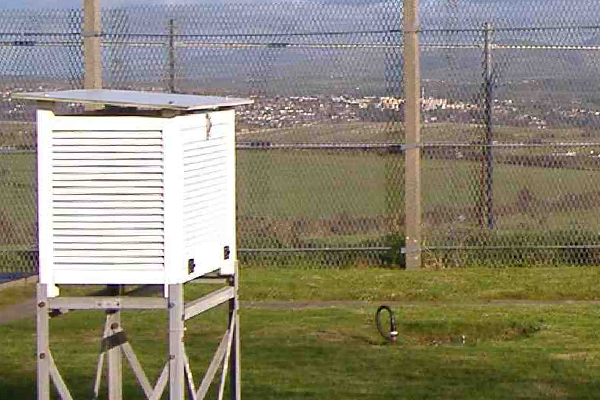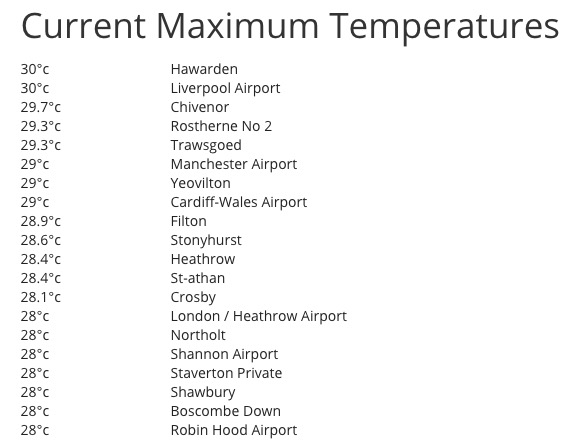The highest UK temperature for 2018 was recorded in Hawarden today – but it was probably hotter in your garden

The highest recorded temperature for 2018 was measured in Hawarden on Tuesday, June 26.
Nothing spectacular in that news really, its summer, temperatures are naturally rising and we are in the middle of a heatwave, but at 1.00pm Hawarden became the warmest place in the UK in 2018 so far – hitting a baking 30.2ºC (86.4ºF)
One ‘Facebooker’ responded saying it was a “lie” and Queensferry was hotter at 32º – several other people got in touch to tell us their car dashboard readings were well over 30º – they probably were!
Another person on ‘FB’ told us it was 40º in their greenhouse – so the news that Hawarden had broken this existing (1 day old) *record must have been fake right?
Phone apps aren’t particularly helpful when it comes to official temperatures – while many are brilliant at what they do, the data used can come from various sources including privately owned weather stations and apps rarely seems to give the same reading as the other.

So, when it comes to officially recorded temperatures (*not to be confused with an official record) there’s a strict criteria used by the Met Office, the UK’s national weather service.
The Met Office says today is the UK’s hottest day of the year so far after a temperature of 30.2C (86.4F) was recorded in Hawarden in north Wales
— Sky News Breaking (@SkyNewsBreak) June 26, 2018
How are official temperatures measured?
Since the 1960’s only observations from stations that meet specific criteria and that are calibrated and regularly checked by the Met Office are used for quoting temperatures.
The Met Office has a weather station network across the whole UK, with more than 200 automatic stations.
One of these stations is at Hawarden Airport, its why Deeside.com always quotes weather reports based on Hawarden data, the two other automated stations closest to Deeside are in Nantwich and Rhyl.
These weather stations measure a large variety of different meteorological parameters, including air temperature; atmospheric pressure; rainfall; wind speed and direction, humidity; cloud height and visibility.
Stations are usually around 40 km apart, enabling us to record the weather associated with the typical low pressure and frontal systems that cross the UK.
Thermometers at stations must be housed in a Stevenson screen (pictured above) with its door facing north.

Stevenson screens
A Stevenson screen is a white slatted box which houses the thermometer away from direct sunlight and allows air to flow freely through it.
The location of the Stevenson screen is important to ensure consistency across sites. It should be mounted at a height of 1.25m on level grassy ground, away from trees and man-made structures.
It should also be at least 20m away from any area of concrete or hard-standing, and only half the area within 100m radius of the screen can be covered with buildings or man-made surfaces.
Thermometers must be housed in a Stevenson screen with its door facing north.
The thermometer itself must measure temperatures to the nearest decimal point. This is why observations from some stations – such as METAR stations at airports – aren’t included in official records, as they normally only record the temperature to the nearest whole number.
*When are maximum temperatures officially recognised as a new record?
Each day real-time data is subject to preliminary quality control before it is released, such as cross-checking against nearby stations.
A record will not become official until thorough quality control has taken place on the data, which may take several months.
How far do records go back?
Met Office standardised daily temperature records were started in the 1960s, however, there are historical paper records for earlier dates held in the National Meteorological Library and Archive.
The Met Office national record for the UK goes back to 1910, although there are others that go back further such as the Central England Temperature Record.
Individual station statistics go back varying lengths of time depending on when each station was opened.
So there you have it – officially recorded data comes from Hawarden and the network of 200 automated weather stations calibrated by the Met Office – anything else like a reading from a back garden in Connah’s Quay, whilst potentially accurate, wouldn’t get a mention on SKY NEWS.
As for the weather for the rest of the week – it’ll be HOT!
Spotted something? Got a story? Email: [email protected]
Latest News
